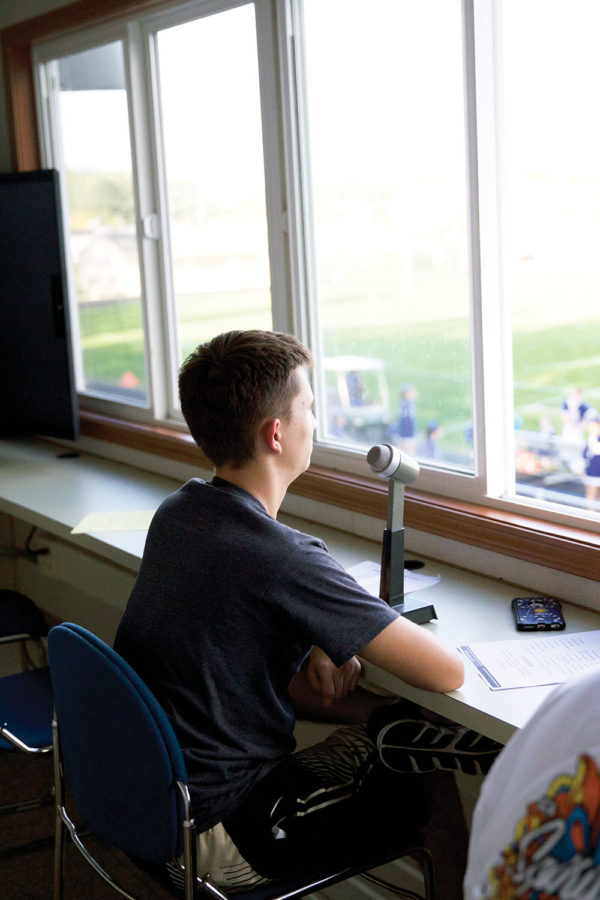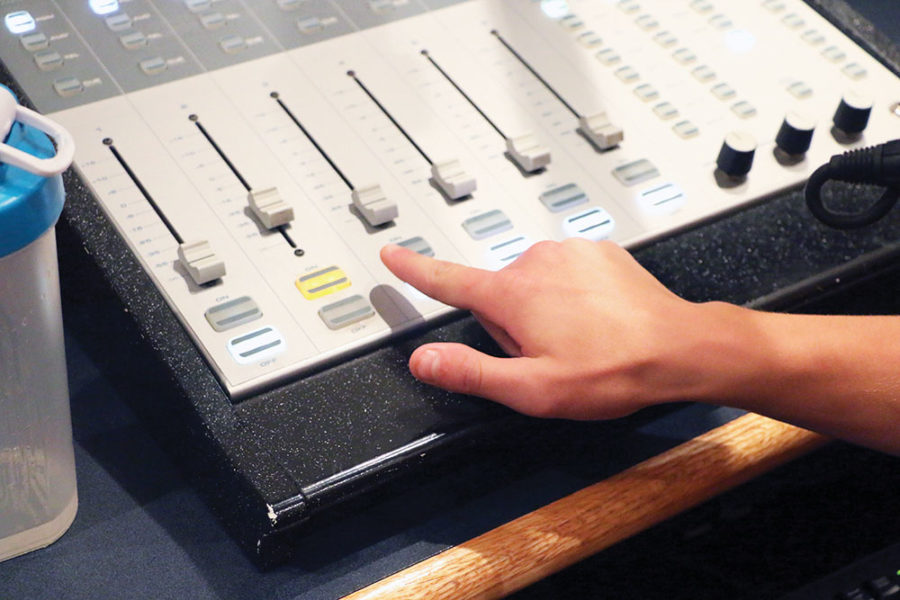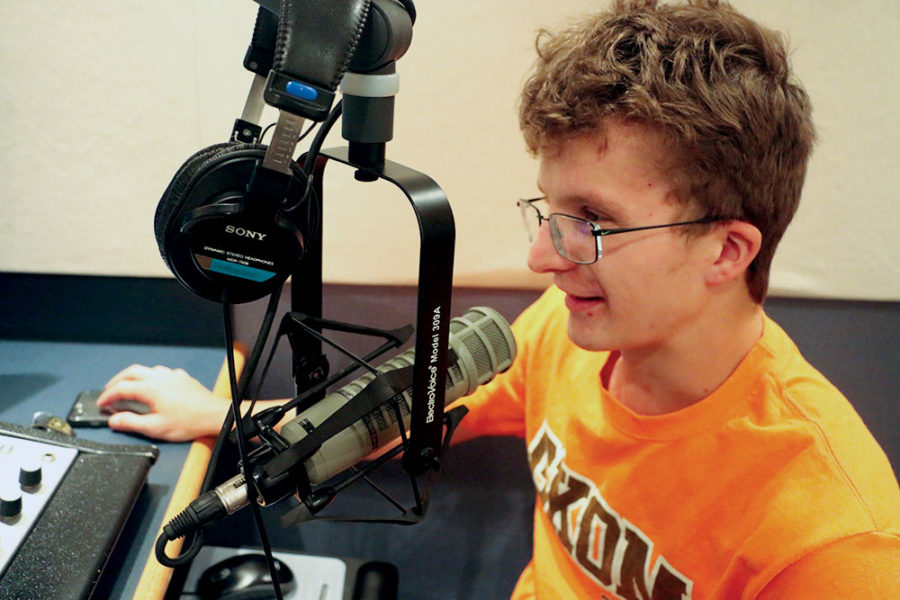Senior Ethan Wakeman is pretty much your average high schooler. He’s a GKOM, and he participates in activities such as cross-country, track and radio. Like many students, he also said he tends to forget to do things. He often struggles with social skills and communication. Wakeman happens to have autism, but, he said, there’s nothing wrong with that.
Wakeman said, “(People with autism are) really not that different. We are different, but we’re all different.”
Robin Rettie, the owner of Lighthouse Learning Resources, a business for people with special needs located in Houston, shared the sentiment that everyone is different in his or her own way, and autism is not particulary different.
“It’s your friend who has autism,” she said. “There’s your friend who has a reading difference. There’s your friend who wears glasses. Every one of us has a difference in some way.”
In an effort to reinforce that concept, Rettie has paired up with the World Autism Organisation (WAO) to help organize the WAO International Congress that will be hosted in Houston from Nov. 12 to 15. According to the WAO website, the congress is open to just about everyone: people with autism, their families, their friends and relevant professionals. It will feature many speakers who will address a variety of topics, focusing on the latest research, practical skills and personal experiences. One featured speaking session will be based on social skills in our schools for students with high-functioning autism spectrum disorder (ASD) in all communities and schools. Wakeman, for example, is at this higher-functioning end of the spectrum.
Another session is titled “Ain’t Just Misbehavin,” alluding to the misbelief that several autistic behaviors are ordinary naughtiness, one of a myriad of misconceptions surrounding the condition. According to Rettie, society is beginning to accommodate for people with autism, but there is still a stigma attached to it that stems from misunderstandings and a lack of awareness.
THE SPECTRUM
Autism is classified as a spectrum disorder. This is due to the broad range of conditions experienced by those who have autism. The American Psychiatric Association’s (APA) Diagnostic and Statistical Manual of Mental Disorders, 5th edition (DSM-5) is currently used in order to diagnose autism, alongside mental disorders such as depressive disorder. Individuals with autism are distinguished as either low-functioning or high-functioning, but these terms do not refer to intellect level or sensory aversion. According to Action Behavior Centers, almost 95 percent of those who have autism have reported to having varying degrees of Sensory Processing Disorder, a disorder which prevents a proper response from forming to sensory signals and sensory stimuli as a whole.
According to Verywell Health, individuals with low-functioning autism may not be able to manage in an academic setting, and they might not be able to speak; therefore, they may use speaking boards and other ways to communicate rather than speaking. Individuals with high- functioning autism can speak, and they are able to manage in an academic setting better than those with low-functioning autism.
DIAGNOSING DIFFERENCES
Children often begin to start showing symptoms of autism from 12 to 18 months old, but there isn’t a set age at which autism is diagnosed. Rettie said it’s more complicated to identify an individual as having a form of high-functioning autism when its compared to diagnosisng a lower-functioning form of autism.
She said, “Behaviorally they might be struggling with changes in routine and social exchange, but people think they’re just getting along fine.”
Asperger’s Syndrome is defined as a high-functioning form of autism.
Junior Shawn Shepherd said in third grade, his elementary school counselor helped test him as part of the process in diagnosing his Asperger’s. He said he had high anxiety when he was in elementary school, which likely also helped people in identifying the diagnosis.

Wakeman, however, was diagnosed with autism when he was 3.
He said, “My mom told me that I was having a speech delay. It’s not like I wasn’t talking. I was talking, just talking too fast, and they couldn’t understand me.”
Although delays due to autism may be exhibited through speech delays, communication troubles and social awkwardness around peers, in Asperger’s and higher-functioning individuals, these delays may not be present. According to Autism Society, for example, Asperger’s does not involve having a speech delay.
Still, Shepherd said he didn’t start talking until he was 3 years old.
“You probably would be shocked by that with how often I talk,” he said. “I’m still trying to catch up on words.”
According to Autism Society, Asperger’s was added to the DSM-5 as a separate disorder in 1994, but in 2013, the DSM-5 combined Autistic Disorder, Asperger’s Syndrome and other developmental disorders under the umbrella term “ASD.” Rettie said the change upset many people, and she said she doesn’t really know why the APA decided to eliminate the individual diagnoses.
Shepherd said combining the disorders bothers him because he still sees the disorders as separate, and Rettie agreed, to an extent.
Rettie said, “I see overlapping characteristics (between Asperger’s and Autistic Disorder), but I could see (Asperger’s) as a separate diagnosis.”
Wakeman, however, said he thinks autism and Asperger’s are pretty much the same thing.
SCHOOL STRENGTHS
Some perceive Asperger’s as a disability, but others perceive it as a strength. Social awkwardness and clumsiness result from Asperger’s, but there may be pros as well. According to director of counseling Rachel Cole, students with Asperger’s have some of the highest GPAs at this school.

“Academically, (students with Asperger’s are) really strong,” Cole said. “They can catch on and learn, depending on what area of study it is, very quickly. They can put things down and move on quickly; they aren’t too hung up on things like some of us.”
Shepherd affirms this statement.
He said, “I would say that (Asperger’s) could be an advantage because I’m actually really good at math. It can bring your IQ up quite a bit, and that was the case for me.”
However, according to the National Center for Biotechnology Information (NCBI), despite this advantage, children with autism were excluded from the mainstream school system before the 1960s, and their education as a whole was neglected. There was a period of growth and acceptance in the school system with autism during the ‘60s, but there still wasn’t enough representation of students with autism in the school system. Rather than being sent to mainstream schools for education, students with autism and other developmental delays were often sent to state-owned educational institutions. These state-owned and supported institutions for intellectually-disabled students were also on the rise during the 1960s.
Rettie said, “(To care for people with autism in the ‘70s, we) stuck them in a warehouse so they would die. They weren’t educable. That was our perception. We always kept them in remote and unchecked places, and horrific things occured.”
One of the most notable and biggest state-run institutions at the time was Willowbrook State School, a facility in New York built to house children and adults with disabilities. In 1972, ABC News investigative reporter Geraldo Rivera exposed Willowbrook to be a very crowded school with bad living conditions, but the school didn’t close until 1987 due to a lawsuit and public opposition. Many former residents have since said a lot of abuse occurred, both sexual and physical, according to Rooted in Rights, a company that produces videos and social media campaigns exclusively on disability rights issues. They said they experienced being beaten by sticks and belt buckles. They said they only had five minutes to clean themselves, all together in a single shower room. They said Willowbrook felt more like a prison than a school.
According to NCBI, the mainstream school system has improved drastically following the Willowbrook State School scandal, as it brought autism and the mistreatment of people with autism to the forefront of the public, leading to reform in education and society. In light of this, schools in recent years have come to accommodate for students with autism more and more.
Since autism is a spectrum disorder, Cole said lesson plans and accommodations are often uniquely curated for each individual student. This is known as an individualized education plan, and according to Cole, the student—in conjunction with a teacher or counselor—writes goals to fill in any gaps the student has in their education. Autism is not a “one-size-fits-all” kind of disorder, and therefore, she said, something may work for one student may not work for another.
MAJOR MEDIA MOVES
According to Rettie, the Willowbrook State School scandal did have a couple of benefits in that autism gained visibility, which in turn led to more community awareness. She said whether related to autism or not, there is a greater awareness and acknowledgement of individuals who may not fit the norm.

Rettie said,“We’re embracing it more, accepting it more, and individuals are coming in to work in different occupations.”
Rettie said the lack of awareness led to the development of several misconceptions, although she said social media has been an incredible tool to combat these misconceptions and stereotypes. However, Wakeman said other organizations and forms of media may not be so satisfactory. He said he sees misconceptions through social media and memes making fun of autistic people. He also cited Autism Speaks, an autism advocacy organization that has raised controversy for various reasons, including its initial mission statement, which stated that it sought a “cure” for autism, according to Psychology Today. The organization has changed its statement since then.
“Why would I support that group if they were trying to cure it in the first place? There are hundreds of others who were never doing it in the first place,” Wakeman said. “There are hundreds of other autism support groups that are actually run by autistics.”
Autism Speaks later appointed a couple of autistic people to its board, but it had already raised alarms from many sources, including news sites, blogs and other autism organizations, which helped put autism into the spotlight in the media.
Shepherd said his mom calls him little Sheldon, referring to Sheldon Cooper from “The Big Bang Theory.” Although the writers of the show claim that they did not write the character as being on the autism spectrum, viewers have theorized that he has Asperger’s. An “Aspie” himself, Shepherd said incorporating ASD into popular culture through TV shows such as “The Big Bang Theory” can be beneficial.
He said, “Then you can understand why people like us do the stuff that we do.”

































![What happened to theater etiquette? [opinion]](https://hilite.org/wp-content/uploads/2025/04/Entertainment-Perspective-Cover-1200x471.jpg)













































![Review: “The Immortal Soul Salvage Yard:” A criminally underrated poetry collection [MUSE]](https://hilite.org/wp-content/uploads/2025/03/71cju6TvqmL._AC_UF10001000_QL80_.jpg)
![Review: "Dog Man" is Unapologetically Chaotic [MUSE]](https://hilite.org/wp-content/uploads/2025/03/dogman-1200x700.jpg)
![Review: "Ne Zha 2": The WeChat family reunion I didn’t know I needed [MUSE]](https://hilite.org/wp-content/uploads/2025/03/unnamed-4.png)
![Review in Print: Maripaz Villar brings a delightfully unique style to the world of WEBTOON [MUSE]](https://hilite.org/wp-content/uploads/2023/12/maripazcover-1200x960.jpg)
![Review: “The Sword of Kaigen” is a masterpiece [MUSE]](https://hilite.org/wp-content/uploads/2023/11/Screenshot-2023-11-26-201051.png)
![Review: Gateron Oil Kings, great linear switches, okay price [MUSE]](https://hilite.org/wp-content/uploads/2023/11/Screenshot-2023-11-26-200553.png)
![Review: “A Haunting in Venice” is a significant improvement from other Agatha Christie adaptations [MUSE]](https://hilite.org/wp-content/uploads/2023/11/e7ee2938a6d422669771bce6d8088521.jpg)
![Review: A Thanksgiving story from elementary school, still just as interesting [MUSE]](https://hilite.org/wp-content/uploads/2023/11/Screenshot-2023-11-26-195514-987x1200.png)
![Review: "When I Fly Towards You", cute, uplifting youth drama [MUSE]](https://hilite.org/wp-content/uploads/2023/09/When-I-Fly-Towards-You-Chinese-drama.png)
![Postcards from Muse: Hawaii Travel Diary [MUSE]](https://hilite.org/wp-content/uploads/2023/09/My-project-1-1200x1200.jpg)
![Review: "Ladybug & Cat Noir: The Movie," departure from original show [MUSE]](https://hilite.org/wp-content/uploads/2023/09/Ladybug__Cat_Noir_-_The_Movie_poster.jpg)
![Review in Print: "Hidden Love" is the cute, uplifting drama everyone needs [MUSE]](https://hilite.org/wp-content/uploads/2023/09/hiddenlovecover-e1693597208225-1030x1200.png)
![Review in Print: "Heartstopper" is the heartwarming queer romance we all need [MUSE]](https://hilite.org/wp-content/uploads/2023/08/museheartstoppercover-1200x654.png)



